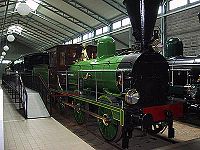
Finnish Railway Museum
Encyclopedia

Hyvinkää
Hyvinkää is a town and municipality of Finland. It is located in Uusimaa region, approximately north of the capital Helsinki. The town was chartered in 1960. Hyvinkää belongs to the Province of Southern Finland. The population of Hyvinkää is ....
, Finland
Finland
Finland , officially the Republic of Finland, is a Nordic country situated in the Fennoscandian region of Northern Europe. It is bordered by Sweden in the west, Norway in the north and Russia in the east, while Estonia lies to its south across the Gulf of Finland.Around 5.4 million people reside...
. It was originally founded in 1898 and located in Helsinki
Helsinki
Helsinki is the capital and largest city in Finland. It is in the region of Uusimaa, located in southern Finland, on the shore of the Gulf of Finland, an arm of the Baltic Sea. The population of the city of Helsinki is , making it by far the most populous municipality in Finland. Helsinki is...
. The museum was moved to Hyvinkää in 1974.
The museum is on the original station and yard site of the Hanko–Hyvinkää railway. In addition to the station building, there is a roundhouse and several other preserved buildings, mainly from the 1870s.
Unique objects are on display, including the only surviving imperial train of the Russian Emperor. There are ten steam locomotive
Steam locomotive
A steam locomotive is a railway locomotive that produces its power through a steam engine. These locomotives are fueled by burning some combustible material, usually coal, wood or oil, to produce steam in a boiler, which drives the steam engine...
s on display, the oldest from 1868. The locomotives include the oldest known British Neilson and Company
Neilson and Company
Neilson and Company was a locomotive manufacturer in Glasgow, Scotland.The company was started in 1836 at McAlpine Street by Walter Neilson and James Mitchell to manufacture marine and stationary engines...
locomotive (0-6-0 No 1427) dating 1869 and a British Beyer Peacock locomotive dating from 1868.
The museum also has a live steam
Live steam
Live steam is steam under pressure, obtained by heating water in a boiler. The steam is used to operate stationary or moving equipment.A live steam machine or device is one powered by steam, but the term is usually reserved for those that are replicas, scale models, toys, or otherwise used for...
backyard railroad
Backyard railroad
A backyard railroad is a privately owned, outdoor railroad, most often in miniature, but large enough for one or several persons to ride on. The rail gauge can be anything from to or more. Smaller backyard or outdoor railroads that cannot be ridden are called garden railroads.Hundreds, even...
track, where train ride
Train ride
A train ride in an amusement park, or a municipal park setting, is a small ride consisting of a miniature train, often running on a permanent or portable track, but sometimes without any track whatsoever. In the latter case, the "trains" are simulated by connecting railroad-like cars behind an...
s are offered to the public during special run days in the summer months.
Address: Hyvinkäänkatu 9, 05800 Hyvinkää, Finland
See also
- VR GroupVR GroupVR or VR Group is a state-owned railway company in Finland. Formerly known as Suomen Valtion Rautatiet until 1922 and Valtionrautatiet / Statsjärnvägarna until 1995...
- List of railway museums Worldwide
- Heritage railways
- List of heritage railways
- Restored trainsRestored trainsRestored trains are historic trains that have been removed from service and later restored to their past condition, as opposed to having never been removed from service, like UP 844, the only U.S. steam locomotive to never be retired. They are operated in present day service as moving examples of...
- Jokioinen Museum RailwayJokioinen Museum RailwayThe Jokioinen Museum Railway is located in Jokioinen, Finland. It is based on the last narrow gauge railway in Finland, the gauge Jokioinen Railway....

